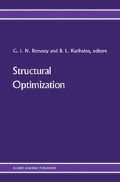Abstract
The procedure necessary to obtain the shape which returns minimum stress concentration involves many choices, and we shall here sum up common personal experiences from solutions to different problems. Parametrization of the design shape is carried out using global expansion functions, very much like modal expansion in vibrational analysis. Finite element modelling is treated independent of design modelling and too simple finite elements are avoided. Linear stress elements are obtained from constant stress elements and this is utilized in the sensitivity analysis, that to a large extent is performed analytically.
Access this chapter
Tax calculation will be finalised at checkout
Purchases are for personal use only
Preview
Unable to display preview. Download preview PDF.
References
Kristensen, E.S. & Madsen, N.F.: ‘On the optimum shape of fillets in plates subjected to multiple in-plane loading cases’. Int. J. Numer. Meth. Engng. 10, 1007–1019, 1976.
Pedersen, P. & Laursen, C.L.: ‘Design for minimum stress concentration by finite elements and linear programming’. J. Struct. Mech. 10, 243–271, 1982–1983.
Dybbro, J.D. & Holm, N.C.: ‘On minimization of stress concentration for three-dimensional models’. Comp. & Struct. 4, 637–643, 1986.
Pedersen, P.: ‘Some properties of linear stress triangles and optimal finite element models’. Int. J. Numer. Meth. Engng. 7, 415–429, 1973.
Pedersen, P.: ‘On computer-aided analytic element analysis and the similarities of tetrahedron elements’. Int. J. Numer. Meth. Engng. 11, 611–622, 1977.
Barthelemy, B. & Haftka, R.T.: ‘Accuracy analysis of the semi-analytical method for shape sensitivity calculation’. To appear in Proceedings of AIAA. SDM Conference. Virginia. Apr. 1988.
Pedersen, P., Cheng, G. & Rasmussen, J.: ‘On accuracy problems for semi-analytical sensitivity analysis’. DCAMM Report No. 367, 15 p., Dec. 1987.
Author information
Authors and Affiliations
Editor information
Editors and Affiliations
Rights and permissions
Copyright information
© 1988 Kluwer Academic Publishers
About this paper
Cite this paper
Pedersen, P. (1988). Design for Minimum Stress Concentration — Some Practical Aspects. In: Rozvany, G.I.N., Karihaloo, B.L. (eds) Structural Optimization. Springer, Dordrecht. https://doi.org/10.1007/978-94-009-1413-1_29
Download citation
DOI: https://doi.org/10.1007/978-94-009-1413-1_29
Publisher Name: Springer, Dordrecht
Print ISBN: 978-94-010-7132-1
Online ISBN: 978-94-009-1413-1
eBook Packages: Springer Book Archive

